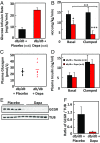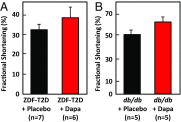Dapagliflozin suppresses glucagon signaling in rodent models of diabetes
- PMID: 28584109
- PMCID: PMC5488956
- DOI: 10.1073/pnas.1705845114
Dapagliflozin suppresses glucagon signaling in rodent models of diabetes
Abstract
Sodium-glucose cotransporter 2 (SGLT2) inhibitors are a class of antidiabetic drug used for the treatment of diabetes. These drugs are thought to lower blood glucose by blocking reabsorption of glucose by SGLT2 in the proximal convoluted tubules of the kidney. To investigate the effect of inhibiting SGLT2 on pancreatic hormones, we treated perfused pancreata from rats with chemically induced diabetes with dapagliflozin and measured the response of glucagon secretion by alpha cells in response to elevated glucose. In these type 1 diabetic rats, glucose stimulated glucagon secretion by alpha cells; this was prevented by dapagliflozin. Two models of type 2 diabetes, severely diabetic Zucker rats and db/db mice fed dapagliflozin, showed significant improvement of blood glucose levels and glucose disposal, with reduced evidence of glucagon signaling in the liver, as exemplified by reduced phosphorylation of hepatic cAMP-responsive element binding protein, reduced expression of phosphoenolpyruvate carboxykinase 2, increased hepatic glycogen, and reduced hepatic glucose production. Plasma glucagon levels did not change significantly. However, dapagliflozin treatment reduced the expression of the liver glucagon receptor. Dapagliflozin in rodents appears to lower blood glucose levels in part by suppressing hepatic glucagon signaling through down-regulation of the hepatic glucagon receptor.
Keywords: SGLT2 inhibition; dapagliflozin; diabetes; glucagon; glucagon receptor.
Conflict of interest statement
The authors declare no conflict of interest.
Figures





References
-
- Madaan T, Akhtar M, Najmi AK. Sodium glucose CoTransporter 2 (SGLT2) inhibitors: Current status and future perspective. Eur J Pharm Sci. 2016;93:244–252. - PubMed
-
- Tahrani AA, Barnett AH, Bailey CJ. Pharmacology and therapeutic implications of current drugs for type 2 diabetes mellitus. Nat Rev Endocrinol. 2016;12:566–592. - PubMed
-
- Hasan FM, Alsahli M, Gerich JE. SGLT2 inhibitors in the treatment of type 2 diabetes. Diabetes Res Clin Pract. 2014;104:297–322. - PubMed
Publication types
MeSH terms
Substances
Grants and funding
LinkOut - more resources
Full Text Sources
Other Literature Sources
Medical
Molecular Biology Databases
Miscellaneous

